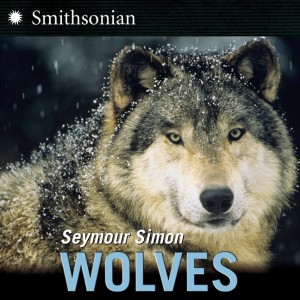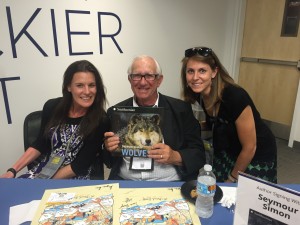Sherry and I presented at the International Literacy Association (ILA) annual conference in St. Louis, Missouri this year and were invited to a special event held by the amazing people at BookSource. There were many authors there who signed copies of their newest books. I was giddy with excitement, mostly because Seymour Simon was one of the authors! I have been a long time fan of his descriptive nonfiction illustrated with stunning photographs. So now, my newest Seymour Simon book is Wolves.
Why I Finished It:
It’s virtually impossible not to finish a Seymour Simon book. Many times I find myself not really reading sequentially, but reading parts and pondering. No one who knows me would confuse me for a nature lover or a science fanatic, but I can never resist any of his nature books. The book begins with Simon asking the reader to imagine snow falling in the woodlands. I have never seen snow (minus the small amount that fell in Texas a few years back) and am not familiar personally with woodlands, but his narrative puts the reader in the setting. A reader’s senses are saturated by the imagery created by Simon. Moreover, as with all Simon books, the photographs are captivating.
Who I Would Give It To:
Essentially everyone. Seymour Simon is bringing nonfiction back! Specifically, all teachers of expository writing (aka everyone) should have this book on their mentor text list.
Integration Ideas:
Writing – Mentor Text
Seymour Simon is gifted at taking information and describing the facts in ways that are engaging and paint a picture for the reader. I use all of his texts in Writers’ Workshop to show students how to explain and describe their information.
Example: “The members of a pack are usually very friendly with one another. They hunt, travel, eat, and make noises together. Wolves bring bits of food to one another. They babysit one another’s litters.” (p. 19) This page continues for a few more sentences.
Have the students “Read Like a Writer“.
- Read aloud that section (or another section). Ask students what they notice. Direct them towards the idea that the writer explains his facts in subsequent sentences. That each sentence after the fact is explained to really paint a picture of the fact.
- Discuss with the students why Seymour Simon decided to use this craft. Prompt students towards the idea that when the author describes his facts it paints a picture for the reader. It helps the reader understand exactly what they are being told.
- Give the craft a name. This will give common language to the class and a way to discuss this craft in the future. In this situation there is no one right answer. Some possibilities are; “adding details”, “explaining facts”, etc.
- Link to other books that use the same technique. This will help students see how other writers use the same craft in a different way. One suggestion in this situation might be Jonathan London’s Hippos Are Huge!
- Help the students apply this craft in their own writing. Ask students to read their expository writing and see if there is a place where they can add explanation. Model for the students in your own writing. Display your own expository draft and find a fact. Highlight the fact and then think aloud to the students. In the think aloud explain how a few extra sentences to explain the fact will help the reader create a picture and understand the information.
Another strategy for brainstorming ideas for expository writing in a Writers Workshop can be found here.
Writing – Thesis or Reading – Main Idea
Each page in this book explains one concept. For example, page 6 is about how wolves are like dogs and lions, page 9 (paragraph 1) is about how wolves are adaptable to different climates and surrounding, and page 16 is all about the wolf’s teeth and hearing. Students can use this organization to discuss what the main idea of each paragraph is. I prefer to use get the gist to find the main idea. Students will read the section, decide who or what the section is about, and then explain what is so important about the who or what in ten words or less.
This organizational structure will also help students emulate writing a thesis. Share thesis statements from the book and provide sample facts to the students. Some of the facts will fit the thesis and others will not. An example might be to share the thesis from page 9 and ask: Can the author add information about how wolves and dogs look alike? Can the author add information about how dogs are domesticated? etc. This helps students begin to realize the power of a thesis. Have students look at their own writing to see if they have a thesis and if it is used correctly, and also encourage students to look for erroneous information or any information that does not support their thesis.
What is your favorite Seymour Simon book?









I’m thrilled and delighted by your writing and suggestions on using my book Wolves as a mentor text in class. You guys really get what teaching is all about! Thank you and have a great school year! -Seymour Simon
Thank you! We are flattered by your compliments.
Please notify me of new posts by email. 🙂
Jessica introduced this text to us at a literacy training. I recently used it to teach main idea and details for writing. After reading the text, I handed out copies of pieces of the text and had students work in partners and independently to write the main idea and details of that particular piece. It was very fun and engaging. Students enjoyed the text information and pictures!
I love how you used this book! I’m so glad the kids loved it too!